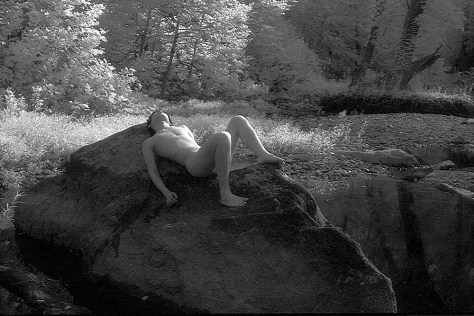Back in June, I was up in New York for a quick getaway. While there, I bought a Contax RTS III camera and 50mm lens. I bought the camera for two reasons: a, because I always wanted one and it was a sweetheart of a deal, and b, because I had a project in mind to use it for. I was cleaning out the film fridge in the basement and discovered I had a half-dozen rolls of Kodak b/w Infrared film sitting there. I always liked that film and what it could do, so I thought I’d shoot my remaining stock of it. Turns out, the old HIE was so old that even though it had been refrigerated, it still had horrible base fog. To boot, the older rolls in the batch also had an emulsion coating problem for which the Kodak HIE was infamous – there were pinholes in the emulsion which would lead to black spots in the image. Back in the day, this was an unforgivable flaw as it was really hard to work around when enlarging. Today, not so bad if you scan your film and can fix it in Photoshop, a pixel at a time if need be. So now it’s not unforgivable, just really annoying. Between the two problems, I decided to forego the Kodak, but I still had the jones on for doing some infrared again.
Efke, an eastern european film manufacturer, still produces an infrared film, with much finer grain than the Kodak had. The downside is that this film is EXTREMELY slow – box speed without a filter is ISO 100. Manual exposure calculation after factoring in the filter puts it around ISO 1. Yes, that’s right. ISO 1. So you should base your exposures on 1 second at f16 in full sunlight. I decided I’d give it a try anyway. Efke makes two versions of their infrared film – 820c and 820c Aura. Allegedly the Aura version has no anti-halation coating so you in theory get the infrared “glow”. I don’t know if there really is a difference in the final results, but I shot this on Aura just in case. To gain maximum infrared effect with this film, I used a Hoya RM72 filter, which is a very deep red filter, almost opaque, and it blocks most of the visible light from recording on film. The results were hit and miss – I chanced it and let the camera meter through the filter, so sometimes I got useable exposures, and sometimes I got bubkes. Here are the best two from the shoot.


I want to give a big thanks to my model, who goes by Eliot K as his professional name on Model Mayhem. He was a real trooper, getting up at 7 AM to get out along the Potomac and shoot while the air was relatively cool (under 90 degrees – this was a real scorcher of a heat wave, with the actual air temperature reaching 98-100 and the heat index putting it up over 102-104 for the high) and the light was rich in infrared. He had the great idea to pack along a cooler with ice and bottled water for us, and it was a life-saver. He also had no problem at least attempting whatever pose I tried to put him in, and never fussed about getting in the river or standing in a bunch of plants, so long as there was no poison ivy (and I know what poison ivy looks like, so that was an easy one to solve).
For those who aren’t familiar with infrared photography, what we’re talking about here is not thermal photography like the night-vision stuff you see in TV and movies. This is photography that is still based on reflected LIGHT – not heat. Infrared photography works with the near-infrared portion of the visible light spectrum, just beyond what your eye can see. You need a specialized red filter to record only the near-infrared portion of the spectrum being reflected by your subject. Otherwise, you’ve just bought some really expensive but otherwise unremarkable black-and-white film. You CAN duplicate this with digital today, but the downside is that in order to do so, you have to permanently alter your camera to shoot infrared, at which point it becomes a dedicated IR camera.